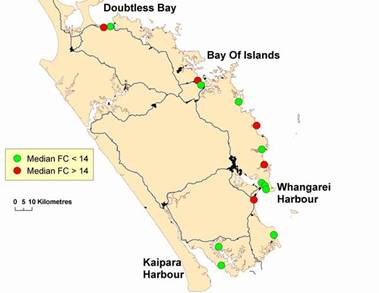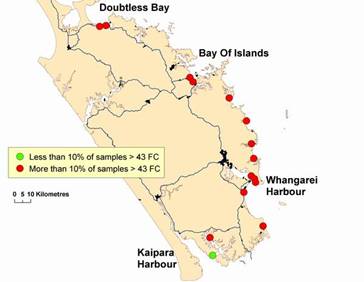Water Quality for Recreational Shellfish Gathering
Within this section…
For 12 weeks over the summer months, NRC undertakes water quality testing at a selection of coastal sites in the region to assess their suitability for recreational shellfish gathering. During the 2007-08 summer season, sampling was undertaken at a total of 15 sites.
The water samples taken are analysed for levels of faecal coliform bacteria. Faecal coliform bacteria can enter water bodies through direct discharge of waste from mammals and birds, from agricultural and storm water runoff and from leaking septic tanks. As shellfish are filter feeders, they may be contaminated and unsafe for human consumption if contamination is present in the water around them.
Two faecal coliform standards are used when assessing water quality for recreational shellfish gathering. In order for a site to be deemed suitable for shellfish gathering, the median for the season must be no more than 14 faecal coliforms per 100 millilitres of seawater AND no more than 10% of samples from the season must exceed 43 faecal coliforms per 100 millilitres of seawater.
Results 2007-08
· Of the 15 sites sampled in 2007-08, the median faecal coliform result for five sites exceeded the limit of 14 per 100 millilitres of seawater.
· Of the 15 sites sampled in 2007-08, 14 had more than 10% of samples that exceeded a faecal coliform count of 43 per 100 millilitres.
· Only one site, Tinopai in the Kaipara Harbour, met both water quality standards for safe recreational shellfish gathering in 2007-08.

Map: Sites monitored for recreational shellfish gathering water quality and whether they complied with the median faecal coliform standard in 2007-08

Map: Sites monitored for recreational shellfish gathering water quality and whether they complied with the standard of no more than 10% of samples exceeding 43 faecal coliforms per 100 ml in 2007-08
One of the main reasons for non-compliance is that the majority of the sites monitored are within semi-enclosed water bodies, such as estuaries and harbours. These water bodies are heavily influenced by freshwater input from rivers and streams and rainfall run-off, both of which transport contaminants into the system. In addition, it takes longer for contaminants to flush out of semi-enclosed systems and water quality may therefore be poorer at these sites for longer than at open coastal locations.
The table below shows water quality results from recreational shellfish gathering sites for the past five years.
Water Quality Guideline Compliance for Recreational Shellfish Gathering in Northland | |||||
| Site | 2003-04 | 2004-05 | 2005-06 | 2006-07 | 2007-08 |
| Ngunguru | Pass | Fail | Fail | Fail | Fail |
| Oakura – north | - | Fail | Fail | Pass | Fail |
| McLeod Bay | - | Fail | Fail | Fail | Fail |
| Taurikura | - | Fail | Fail | Fail | Fail |
| Urquharts Bay | - | Fail | Fail | Pass | Fail |
| Pataua | Fail | Fail | Fail | Fail | Fail |
| Waitangi | Pass | Fail | Pass | - | Fail |
| Te Haumi River | - | Pass | Pass | - | Fail |
| Tinopai | - | Fail | Fail | Fail | Pass |
| Ruakaka | - | Fail | Pass | Pass | Fail |
| Mangawhai | Fail | Fail | Fail | Fail | Fail |
| Pahi | - | Fail | Fail | Fail | Fail |
| Taipa | Fail | Fail | Pass | Pass | Fail |
| Coopers Beach | Pass | Pass | Fail | Fail | Fail |
| Whananaki | - | - | - | - | Fail |
